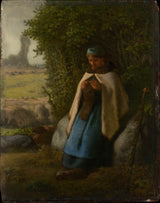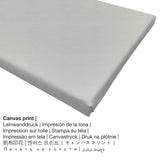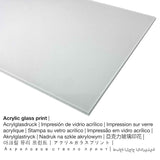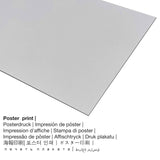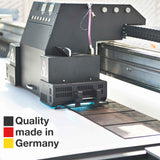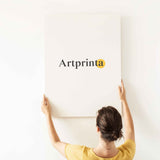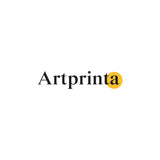Jean-François Millet, 1856 - Onye ọzụzụ atụrụ nọ ọdụ n'elu nkume - mbipụta nka mara mma.
Ụtụ gụnyere. Mbupu gbakọrọ na ndenye ọpụpụ.
Mpempe akwụkwọ nka mara mma nkeonwe gị
In 1856 onye omenkà Jean Francois Millet created the masterpiece. The beyond 160 year-old original version measures the size: 14 1/8 x 11 1/8 in (35,9 x 28,3 cm) and was painted with the medium mmanụ n'elu osisi. Ihe ọzọ, artpiece bụ akụkụ nke Ụlọ ihe ngosi nka nke Metropolitan nchịkọta na New York City, New York, Njikota Obodo Amerika. Site n'ikike nke - The Metropolitan Museum of Art, New York, Gift of Douglas Dillon, 1983 (license: public domain). Additionally, the artpiece has the creditline: Gift of Douglas Dillon, 1983. Ihe ọzọ bụ, alignment bụ na Eserese format ya na oke nke 3: 4, nke pụtara na ogologo bụ 25% mkpụmkpụ karịa obosara. Jean-François Millet was a painter from France, whose artistic style was mainly Realism. The artist lived for 61 years, born in 1814 ma nwụọ na 1875 na Barbizon.
Nweta ihe kacha amasị gị
Maka mbipụta nka ọ bụla mara mma anyị na-enye ụdị nha na ihe dị iche iche. Ị nwere ike ịhọrọ nha na ihe kachasị amasị gị n'ime nhọrọ ndị a:
- Kwaaji: A printed canvas, not to be mistaken with an artwork painted on a canvas, is a digital copy printed directly on canvas. Canvas prints are relatively low in weight, which implies that it is easy to hang your Canvas print without extra wall-mounts. A canvas print is suited for all types of walls.
- Akwụkwọ mmado na ihe kwaaji: A poster is a printed sheet of canvas with a slight surface structure. Please bear in mind, that depending on the size of the canvas poster print we add a white margin of approximately 2-6cm round about the print, which facilitates the framing with a custom frame.
- Mbipụta aluminom (aluminium dibbond): An Aluminium Dibond print is a material with an impressive depth. The Aluminium Dibond Print is your best start to art replicas with aluminum. The bright parts of the work of art shimmer with a silky gloss, however without the glow. The direct print on Aluminum Dibond is one of the most demanded entry-level products and is a truly stylish way to display art, as it puts the viewer’s attention on the artwork.
- Mpempe iko acrylic na-egbuke egbuke: A glossy print on acrylic glass, which is often described as a print on plexiglass, makes the original into brilliant décor. Your own copy of the artwork will be manufactured thanks to state-of-the-art UV direct printing machines.
Ederede iwu dị mkpa: We try all that we can to depict our art products as clearly as we can and to exhibit them visually on the different product detail pages. Please bear in mind that some pigments of the print products and the printing can vary somehwat from the image on your screen. Depending on your settings of your screen and the condition of the surface, color pigments might not be printed one hundret percent realistically. Bearing in mind that all fine art prints are processed and printed by hand, there might as well be slight differences in the motif's size and exact position.
Nkọwa ngwaahịa
| Ụdị ngwaahịa: | nka nka |
| Usoro mmeputakwa: | dijitalụ mmeputakwa |
| Usoro mmepụta: | Mbipụta UV / dijitalụ |
| Mmalite ngwaahịa: | German mmepụta |
| Ụdị ngwaahịa: | a na-achọ |
| Eji ngwaahịa emebere: | ihe ndozi mgbidi, mma mgbidi |
| Ndepụta: | nhazi ihe osise |
| Ụdị anya: | ( Ogologo: obosara) 3: 4 |
| Ihe: | ogologo bụ 25% mkpụmkpụ karịa obosara |
| Nhọrọ akụrụngwa: | Mpempe akwụkwọ, akwụkwọ mmado (akwụkwọ akpa), mbipụta enyo acrylic (nwere ezigbo mkpuchi iko), mbipụta ọla (aluminium dibbond) |
| Mbipụta kanvas (akwa akwa n'elu etiti ihe ndọtị) ụdị nha dị iche iche: | 30x40cm - 12x16", 60x80cm - 24x31", 90x120cm - 35x47", 120x160cm - 47x63" |
| Mbipụta iko acrylic (nwere ezigbo mkpuchi iko) nhọrọ nha: | 30x40cm - 12x16", 60x80cm - 24x31", 90x120cm - 35x47", 120x160cm - 47x63" |
| Mpempe akwụkwọ mmado (akwụkwọ kwaaji) nha dị iche iche: | 30x40cm - 12x16", 60x80cm - 24x31", 90x120cm - 35x47" |
| Nhọrọ mbipụta aluminom: | 30x40cm - 12x16", 60x80cm - 24x31", 90x120cm - 35x47" |
| Nhazi nke nka nka: | enweghị etiti |
Nkọwapụta nka nka
| Aha nka: | "Shepherdess Seated on a Rock" |
| Nhazi nka: | sere |
| Nhazi nka: | nkà nke oge a |
| Time: | 19th narị afọ |
| Emepụtara na: | 1856 |
| Afọ nka: | 160 afọ |
| Ihe osise izizi: | mmanụ n'elu osisi |
| Nha izizi nka: | 14 1/8 x 11 1/8 na (35,9 x 28,3 cm) |
| Egosiputara na: | Museumlọ ihe ngosi nka nke Obodo |
| Ebe ebe ngosi nka: | New York City, New York, Njikota Obodo Amerika |
| Weebụsaịtị nke ihe ngosi nka: | Museumlọ ihe ngosi nka nke Obodo |
| License: | ngalaba ọha |
| Site n'aka: | The Metropolitan Museum of Art, New York, Gift of Douglas Dillon, 1983 |
| Ebe kredit nke ọrụ nka: | Gift of Douglas Dillon, 1983 |
Ihe omuma ihe nka
| aha: | Jean Francois Millet |
| okike onye nka: | nwoke |
| Nationality: | French |
| Ọrụ onye na-ese ihe: | onye na-ese ihe |
| Mba onye si: | France |
| Otu nka: | omenkà nke oge a |
| Ụdị nka: | Ihe ngosi |
| Ndụ: | 61 afọ |
| Afọ ọmụmụ: | 1814 |
| Nwụrụ n'afọ: | 1875 |
| Nwụrụ na (ebe): | Barbizon |
Edochiri ederede a site na nwebiisinka © | Artprinta (www.artprinta.com)
What does the original description of the The Metropolitan Museum of Art write about this work of art from the painter Jean-François Millet? (© - by The Metropolitan Museum of Art - Museumlọ ihe ngosi nka nke Obodo)
Millet had almost finished a painting of the same subject in 1856 (Cincinnati Art Museum), when the young American artist Edward Wheelwright admired it in his studio and asked to buy it. As that work was promised to a patron, Millet agreed to make a replica. Wheelwright recalled that Millet took the second version to the same state of completion as the original, and then "worked on the two pictures alternatively," advancing on one, then turning to the other, and "in this way making both . . . better than either would have been without the rivalry." Wheelwright selected the one now in Cincinnati.

